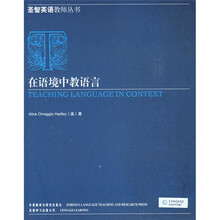Preface F16
Acknowledgments F21
1 On Knowing a Language
Introduction
Defining Language Proficiency
Proficiency and Language Acquisition Theory
Some Research Findings about Oral Proficiency
Issues in Language Proficiency Assessment:Caveats,Clarifications,and New Directions
Defining the Content of Instruction:The Standards forFore~LanguageLearning
Summary:On Knowing a Language
Activities for Review and Discussion
References
2 On Learning a Language
Introduction
Exploring Theories of Language Learning
The Role of Individual Learner Factors in Second—Language Learning
Relating Theory to Practice:Some Considerations
Summary:On Learning a Language
Activities for Review and Discussion
References
3 On Teaching a Language
Orienting Instruction toward Proficiency
The Proficiency Orientation of Existing Methodologies:A PreliminaryAppraisal
Three“Traditional”Methods
Reactions to Audiolingualism:Two Mentalist Perspectives
A Functional Approach:Communicative Language Teaching
Modem Adaptations of the Direct Method
Humanistic Approaches to Language Teaching
Summary:On Teaching a Language
Activities for Review and Discussion
References
4 The Role of Context in Comprehension and Learning
The Importance of Context and Background Knowledge in theComprehension Process:Some TheoreticalConsiderations
Research on the Role of Context in Comprehension
The Role of Computers in Providing Richer Contexts forLanguage Learning
Integrating Language and Content:Immersion and Content-BasedInstruction
Summary:The Role of Context in Comprehension and Learning
Activities for Review and Discussion
References
5 A Proficiency-Oriented Approach to Listening and Reading
A Rationale for Teaching Listening and Reading
Similarities in Listening and Reading
Differences between Spoken and Written Discourse
Integrating Listening,Reading,and the Productive Skills:The Vision of the StandardsforForeignLanguageLearning
Teaching Listening Comprehension
Sample Formats for Listening Comprehension
Teaching Reading Comprehension
Sample Formats for Reading Comprehension
Summary:A Proficiency-Oriented Approach to Listening and Reading
Activities for Review and Discussion
References
6 Developing Oral Proficiency
The Nature of Interlanguage
Planning Instruction for the Development of Oral Proficiency
Responding to the Learner
Summary: Developing Oral Proficiency
Activities for Review and Discussion
References
7 Becoming Proficient in Writing
Approaches to Teaching Writing at the Lower Levels of Proficiency
Expressive Writing at the Intermediate and Advanced Levels: Approaches to Teaching the Composing Process
Summary: Becoming Proficient in Writing
Activities for Review and Discussion
References
8 Teaching for Cultural Understanding
Introduction
Problems in the Teaching of Culture
Definitions, Models, Inventories, and Frameworks: Capturing the Essence of "Culture"
Strategies for Teaching Culture
Summary: Teaching for Cultural Understanding
Activities for Review and Discussion
References
9 Classroom Testing
Introduction
The Case for Hybrid Classroom Tests
Characteristics of Test Items and Item Types
Listening Comprehension Formats
Reading Comprehension Formats
Writing and Mixed-Skills Formats
Guidelines for Creating Contextualized Paper-and-Pencil Tests
Testing Oral Skills
Summary: Classroom Testing
Appendix
Activities for Review and Discussion
References
Epilogue Planning Instruction for the Proficiency-Oriented Classroom
Setting Goals for a Proficiency-Oriented Program
Guidelines for Planning Lessons
Increasing Focus on Students Interests
In Conclusion
Activities for Review and Discussion
References
Appendix A ACTFL Proficiency Guidelines——Speaking Revised 1999
Appendix B Sample Foreign Language Media Evaluation Criteria
Appendix C Samples of Error Coding Procedures for Written Work
Text Permissions
Index

 缺书网
缺书网 扫码进群
扫码进群






